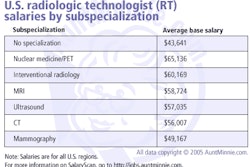LAS VEGAS - Radiology practices in the U.S. face a number of challenges to their fiscal health. Reimbursement is declining while costs continue to rise. Complex billing and coding guidelines are constantly changing, and payment policies vary from payor to payor.
However, by proactively and aggressively instituting a policy of claims denial management, a radiology group can capture a chunk of lost revenue and improve its billing processes, according to a presentation Monday afternoon at the Radiology Business Management Association (RBMA) radiology summit.
"There are approximately 15 billion claims generated per year in the U.S.," said Charlotte Kohler, director of Navigant Consulting in Baltimore. "Of these, about 30% are rejected, and 50% of that 30% are never resubmitted. That's 2.25 billion claims that are never paid and become uncompensated care when an available funding source or payor exists."
According to Kohler, not pursuing reimbursement on claims denial is contributing to the bottom line of every healthcare insurer in the U.S. For a radiology practice leaving an average of 15% of its annual gross billable revenue on the table, this is not a comforting thought.
"If your denial rate is 10% or higher, you have some work to do," she noted.
Kohler cited four reasons why billing denials represent nearly one-third of filed claims by a practice:
- Most denials begin at the point the patient is scheduled.
- Inadequate information technology in the practice.
- Changes in billing and coding regulations.
- Lack of staff training.
"Denials are a good indication that there are things going on in the practice that we're not capturing," she observed.
Kohler advocates that practices institute a comprehensive policy of denial management. She said this involves the following:
- Limiting the number of denials.
- Analyzing the existing denials to establish trend data.
- Identifying the source of denials.
- Implementing corrective action.
- Conducting both prospective and retrospective reviews.
- Getting paid.
A radiology group should strongly consider establishing a coordinator of denial management activity, Kohler said. This person would be in charge of denial hunting, which should be defined and captured in the department's RIS. The denials would be prioritized and then attacked: first with a phone call to the payor, then with submission of corrected claims and additional information, and finally with a formal appeal as part of an overall denial resolution strategy.
As part of this process, Kohler advocates that a group should establish a baseline of net reimbursement that it intends to recover for its services.
"Set up your net amount to be collected. If it doesn't come in, investigate," she said. "This way, you'll get a handle on problems earlier."
As part of the denial management process, a radiology practice should develop a systematic approach to tracking its denials. This involves establishing how many denials are received, determining the amount of revenue that's lost, defining what type of denials are issued, and tracking which payor is issuing what sort of claim denial. All documentation involved in the appeals process should be archived.
This data collection will enable the practice to identify its top five to 10 reasons for denials and where they occur, as well as establish a benchmark of claims volume in comparison with denials and revenue. Sharing the results -- and corrective actions to mitigate denials -- will improve communication among physicians, the billing department, and the front office staff, Kohler said.
The benefits for the practice are increased cash flow, a reduction in write-offs, improved management information and business processes, and closer adherence to state and federal billing compliance, she said.
The sooner a practice puts a process in place for denials management, the better -- as most payors have time limits for claims appeals.
"Accounts receivable is not like a fine wine or a good cheese, they do not get better with age," Kohler said.
By Jonathan S. Batchelor
AuntMinnie.com staff writer
June 8, 2005
Related Reading
HIPAA TCS standards provide business intelligence opportunities, February 17, 2005
Compliance program provides protection, metrics, August 2, 2004
Automated claim coding pays off in time and money, May 11, 2004
Diligent coding means money in the bank for breast imaging, May 21, 2004
Billing mistakes cost Medicare $11.6 billion, U.S. says, November 17, 2003
Copyright © 2005 AuntMinnie.com



















